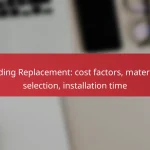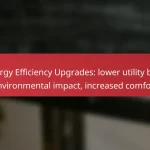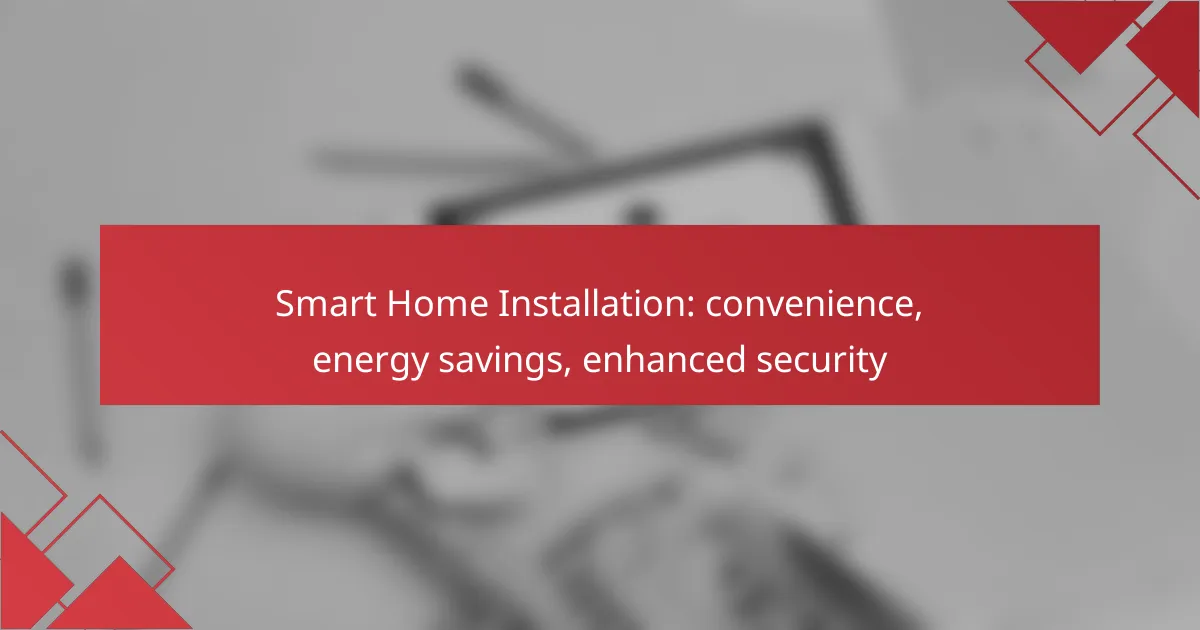Smart home installation provides homeowners with a range of benefits, including increased convenience, energy savings, and enhanced security. By integrating various devices, these systems allow for remote control and automation, leading to a more efficient living environment. Additionally, smart technology optimizes energy usage and offers advanced security features, ensuring both cost-effectiveness and peace of mind.

What are the benefits of smart home installation in the UK?
Smart home installation in the UK offers significant advantages, including enhanced convenience, energy savings, and improved security. These systems integrate various devices to create a seamless living environment that can be controlled remotely, leading to a more efficient and secure home.
Convenience through automation
Smart home technology allows for automation of daily tasks, making life easier. Devices such as smart lights, thermostats, and appliances can be programmed to operate on schedules or controlled via smartphone apps, enabling users to manage their homes from anywhere.
For example, you can set your heating to turn on before you arrive home, ensuring a warm environment upon your return. Voice-activated assistants can also streamline tasks by allowing you to control devices with simple commands.
Energy savings with smart thermostats
Smart thermostats contribute to energy savings by optimizing heating and cooling based on your habits. These devices learn your preferences and adjust temperatures accordingly, which can lead to reductions in energy consumption of around 10-20%.
In the UK, many smart thermostats are compatible with energy providers, allowing users to take advantage of time-of-use tariffs. This means you can program your heating to operate during off-peak hours when energy rates are lower, maximizing savings.
Enhanced security with smart cameras
Smart cameras enhance home security by providing real-time monitoring and alerts. These devices can be accessed remotely, allowing homeowners to check on their property from anywhere, which is particularly useful for those who travel frequently.
Many smart cameras come equipped with features such as motion detection, night vision, and two-way audio. In the UK, integrating these cameras with a smart home system can provide a comprehensive security solution, deterring potential intruders and ensuring peace of mind.

How does smart home installation improve energy efficiency?
Smart home installation enhances energy efficiency by automating and optimizing energy use in various systems. This technology allows homeowners to monitor and control their energy consumption, leading to significant savings and reduced environmental impact.
Smart lighting systems
Smart lighting systems adjust brightness and color based on occupancy and time of day, which can significantly lower energy usage. For instance, motion sensors can turn lights off when a room is unoccupied, while timers can ensure lights are only on when needed.
Many smart lighting solutions are compatible with energy-efficient LED bulbs, which consume less power than traditional incandescent bulbs. Homeowners can save up to 80% on lighting costs by switching to smart LED systems.
Energy monitoring devices
Energy monitoring devices track real-time energy consumption, providing insights into which appliances use the most power. This data allows homeowners to make informed decisions about energy use, potentially reducing costs by identifying energy hogs.
Some devices offer features like alerts for unusual energy spikes, helping to catch issues early. Investing in a good energy monitor can lead to savings of 10-30% on monthly energy bills, depending on usage patterns and adjustments made.
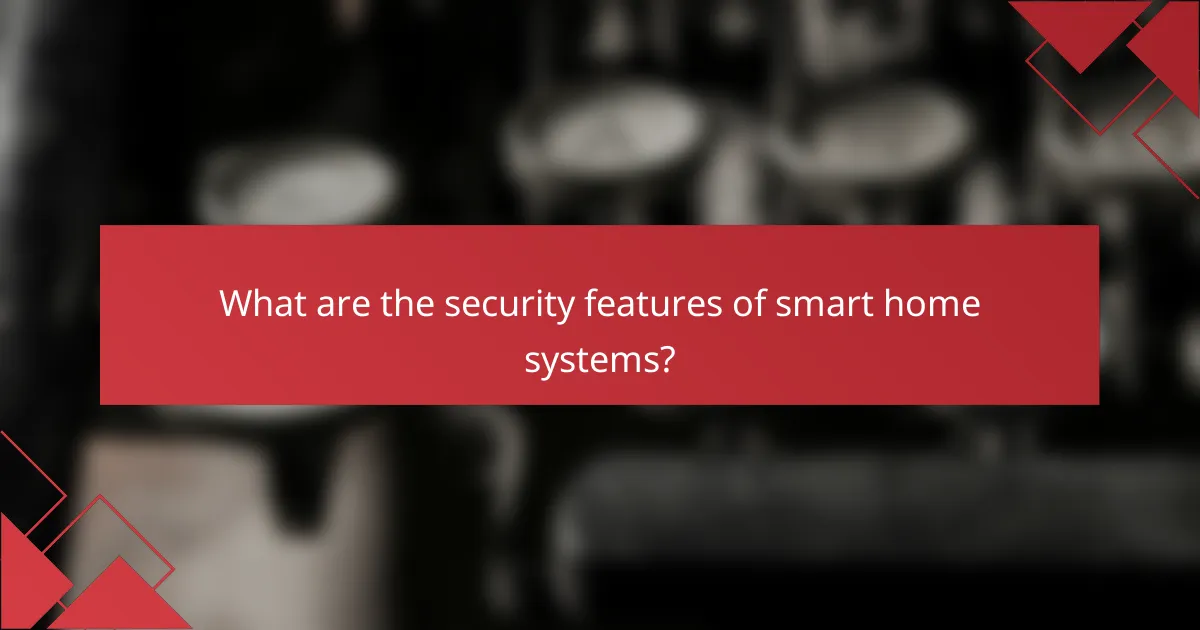
What are the security features of smart home systems?
Smart home systems offer various security features designed to enhance safety and control. These include smart locks, surveillance cameras, and integrated alarm systems that work together to provide real-time monitoring and access management.
Smart locks and access control
Smart locks allow homeowners to control access to their property remotely, using smartphones or keypads. They often include features like temporary access codes for guests and the ability to monitor who enters and exits your home.
When choosing smart locks, consider compatibility with your existing doors and security systems. Look for models that offer encryption and two-factor authentication to enhance security. Popular brands include August, Schlage, and Yale, which provide various options tailored to different needs.
Real-time surveillance options
Real-time surveillance options include indoor and outdoor cameras that can stream video directly to your devices. Many systems offer motion detection alerts, night vision, and cloud storage for recorded footage, ensuring you can monitor your home at any time.
When selecting surveillance cameras, consider factors such as resolution, field of view, and integration with other smart home devices. Brands like Ring, Arlo, and Nest provide comprehensive solutions that can be customized to fit your security requirements. Ensure that your Wi-Fi network can support the bandwidth needed for high-quality video streaming.
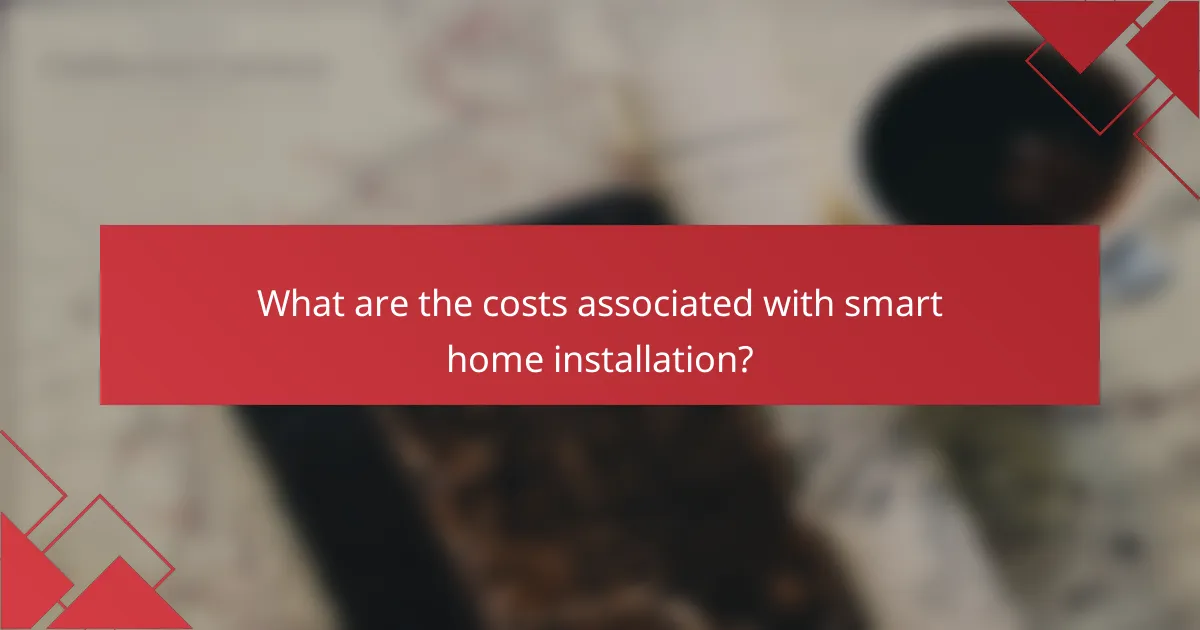
What are the costs associated with smart home installation?
The costs associated with smart home installation can vary widely based on the complexity of the system and the specific devices chosen. Generally, you can expect both initial setup costs and ongoing maintenance expenses that contribute to the overall investment in a smart home ecosystem.
Initial setup costs
Initial setup costs for smart home systems typically range from a few hundred to several thousand dollars. This includes the price of smart devices such as thermostats, security cameras, lighting systems, and hubs, as well as installation fees if you hire professionals.
For example, a basic setup with smart lighting and a thermostat might cost around $300 to $800, while a comprehensive security system with multiple cameras and sensors could exceed $2,000. It’s crucial to assess your needs and budget accordingly before making purchases.
Ongoing maintenance expenses
Ongoing maintenance expenses for smart home systems generally include subscription fees for services, software updates, and potential repairs or replacements. Many smart devices require a monthly or annual subscription for premium features, which can add up over time.
For instance, cloud storage for security camera footage may cost around $5 to $30 per month, depending on the amount of data stored. Additionally, consider the potential costs of replacing batteries or devices that may wear out, which can further impact your budget.

What factors should be considered when choosing smart home devices?
When selecting smart home devices, consider compatibility with your existing systems, user-friendly interfaces, and the specific needs of your household. These factors will ensure seamless integration and enhance your overall experience.
Compatibility with existing systems
Compatibility is crucial when choosing smart home devices, as it determines how well new devices will work with your current setup. Check if the devices support common standards like Zigbee, Z-Wave, or Wi-Fi, which can facilitate communication between devices from different manufacturers.
For example, if you already have a smart hub, ensure that any new devices can connect to it. This will help you avoid the frustration of having devices that cannot communicate with each other, which can limit functionality and convenience.
User-friendly interfaces
A user-friendly interface is essential for managing smart home devices effectively. Look for devices that offer intuitive apps or voice control options, making it easy to monitor and control your home environment.
Consider how often you will interact with the device and choose options that simplify tasks. For instance, devices with customizable settings or automation features can enhance usability, allowing you to tailor the system to your preferences without unnecessary complexity.
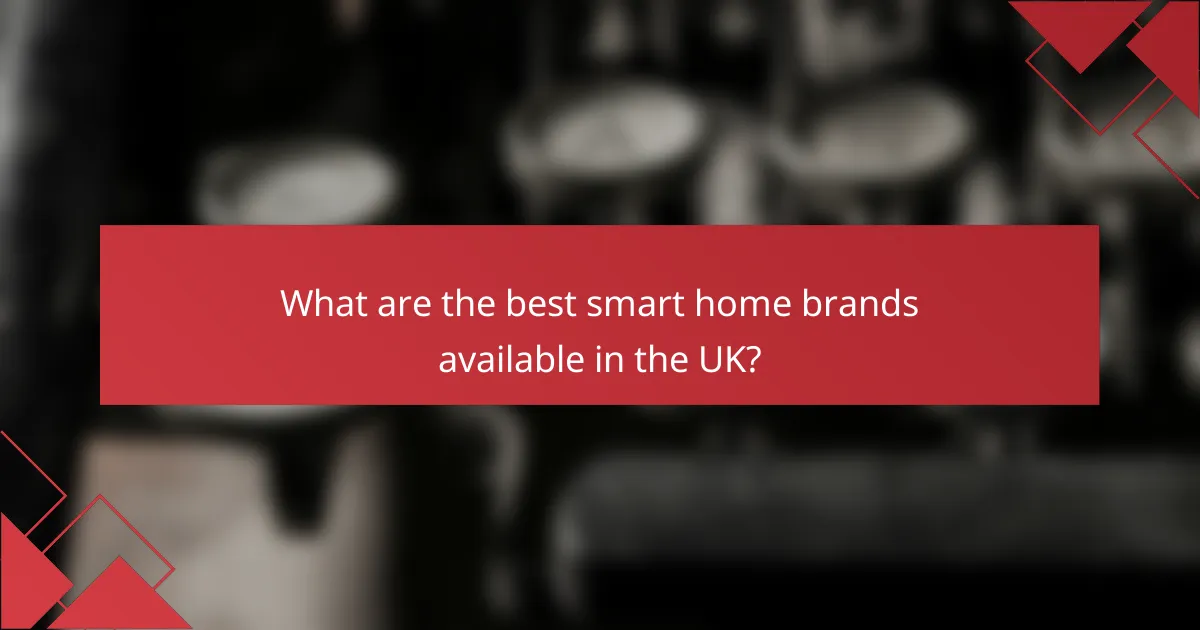
What are the best smart home brands available in the UK?
The best smart home brands in the UK include Google Nest, Amazon Echo, and Philips Hue. Each brand offers unique features that enhance convenience, energy savings, and security in smart home systems.
Google Nest
Google Nest provides a range of smart home devices, including smart speakers, thermostats, and security cameras. Their products integrate seamlessly with Google Assistant, allowing for voice control and automation of various home functions.
When considering Google Nest, think about compatibility with existing devices and the potential for energy savings through smart thermostats. For example, the Nest Learning Thermostat can learn your schedule and adjust temperatures accordingly, potentially reducing heating costs by up to 15%.
Amazon Echo
Amazon Echo devices serve as central hubs for smart home control, utilizing Alexa for voice commands. They can manage various compatible devices, from lights to locks, providing a unified experience.
Choosing Amazon Echo means considering the extensive ecosystem of compatible devices. The Echo Show, for instance, offers a screen for video calls and smart home monitoring, enhancing security and convenience. Ensure your selected devices are Alexa-compatible for optimal performance.
Philips Hue
Philips Hue specializes in smart lighting solutions that can be controlled via an app or voice commands. Their products allow users to customize lighting settings, creating ambiances that suit different activities or moods.
When implementing Philips Hue, consider the range of bulbs and fixtures available, as well as the potential for energy savings through LED technology. A starter kit typically includes a hub and several bulbs, making it easy to begin transforming your home lighting.

How can smart home technology enhance daily living?
Smart home technology enhances daily living by providing convenience, energy savings, and improved security. By integrating devices that can be controlled remotely, homeowners can streamline their routines, reduce utility costs, and monitor their properties more effectively.
Remote control capabilities
Remote control capabilities allow homeowners to manage their smart devices from anywhere using smartphones or tablets. This feature enables users to adjust lighting, heating, and security systems in real-time, enhancing comfort and efficiency.
For example, you can turn off lights left on during the day or adjust your thermostat while away from home. Many systems support voice commands, making it even easier to control devices without needing to physically interact with them.
When setting up remote control features, ensure your Wi-Fi network is robust and secure to prevent unauthorized access. Consider using two-factor authentication for added security when accessing your smart home systems remotely.
